Beer is a beverage that everybody loves. You may watch a show you love with relatives, close companions, or alone on a calm evening. They’re pleasant for drinking and don’t have much booze, meaning you can have as much as you want.
But have you considered what ingredients comprise beer? How do they get their flawlessly pleasant taste? Here’s an instant overview of the critical components of beer.
Table of Contents
ToggleWhat Are The Ingredients Used To Make Beer?

Beer is an intoxicating drink created from fermented grains. Various blends of cereal grains require multiple phases of processing and fermentation to produce carbonated drinks that vary in color from soft gold to dark amber to almost black. The beer possesses four primary components: hops, water, grain, and yeast.
1. Grain
Most of the time, barley grains soaked in water serve to create beer. When fermentation, the starches within them are changed to sugars that mix with the yeast to develop booze. Several variables are impacted by the grains in beer.
The hue of the grains will impact the color of the last drink if it’s a bright blonde lager or a stout that is as black as the midnight sky. Other substances in a beer named dextrins change its density, meaning how thick or thin it becomes. Additionally called “mouthfeel.”
And the proteins they use to keep the head on top of a drink dense. With evidently, they change their flavor. The malt flavor sticks out in comparison with the hops. ‘Malty’ beers will likely appear firmer, darker, and smoother.
2. Hop
Hops come from the blossoms of the Humulus lupulus plant. Hops offer beer bitterness, taste, and form. Most of the time, they come in during the boil while heat draws out the correct substances. The hop applied has a significant impact on how the beer tastes.
Their bitterness helps smooth out the sugary taste of the malt, yet they possess plenty of different flavors that add depth to the tasting variety. It’s good for the nose and on your mouth. Hops draw the scents of a new beer, which arise from the plant’s oily essence.
While you test more beers, you’ll become used to the “hoppy” flavor that is especially apparent in IPAs. Lastly, hops offer stability, which is a crucial aspect. Beer lasts for a while as it is antibacterial and destroys germs that hinder the beverage.
Hops have been used for creating beer for many years. Their initial recorded use was in the ninth century. Before that, people had tried various sour herbs and blossoms, like burdock root, marigold, and dandelion. When hops were found, however, drinkers didn’t look back.
3. Yeast
Another vital variable is yeast. Yeast is a live, fungal microorganism that helps in the fermentation process to turn sugars into booze. Every beer is either lagers or ales. The distinction is in their yeast and the temperature where they develop.
Lager typically begins with “Saccharomyces pastorianus,” yeast that converts at the bottom (less temperature). Ale typically starts with “Saccharomyces cerevisiae,” that’s also called “Brewer’s Yeast,” while it is top-fermented (happens at high temperatures).
4. Water
Lastly, water. Beer wouldn’t taste pleasant without it. Beer has 90% water; that’s why bars have toilets. Water in beer requires having high-quality. Top brewers care about water quality since mineral content impacts flavor. The finest beer undoubtedly doesn’t come from a tap.
How Does The Beer Production Process Work?

Brewing is complex, technological, and artistic. Apply these instructions to make this drink famous—five stages to produce beer.
- Sanitize: Disinfect and clean your work area before brewing to avoid beer spoilage and bitterness. Airborne microorganisms and cooking tools may spoil beer. Brewers don’t like contaminated beer.
- Mash: Grain enzymes change complex starches to sugars and alcohol while mashing. In a mash tun, grains with water make wort. Malted barley and additional grains create sweet wort. Malt enzymes turn starches into sugars.
- Separate: The false bottom of the mash tun allows the brewer to distinguish solid malt from liquid wort. A pump or gravity may separate wort and malt. Then, the boiler gets the wort. The brewer washes the malt using steaming water to remove all sugars and adds them to a boiler for wort collection.
- Wort Boil: Boiling starts when the wort is collected from malt. Brewers have numerous goals by boiling. Sterilizing the wort guarantees just the brewer’s yeast can ferment. Brewers add hops to their kettle. Hops are antibacterial, yet they mainly have aroma, taste, and sour beer. Boiling precipitants proteins from the wort, offering the brewer pure wort for the yeast and pure beer to the drinker.
- Ferment: Fermentation converts wort sugar to alcohol and CO2. The wort cools down, and yeast is included to make alcohol. Following two weeks, you’ll drink beer.
Main Beer Types
Lagers and ales are major beer types. Fermentation using various yeasts and temperatures separates these two kinds.
1. Ales
Yeasts turn carbohydrates into alcohol and carbon dioxide at ambient temperature to create ales. Ales are usually top-fermented since the yeast floats on top.
- India Pale Ales
- Cream Ales
- Pale Ales
- Belgian Style Ale
- Brown Ales
- Sour Ales
- Dark Ales
2. Lagers
Lagers employ yeast that sets at cooler temperatures. Lagers are bottom-fermented since the yeasts grow at the bottom.
- Amber and red lager
- Pale Lager
- Dark Lager
- Pilsner
Does Drinking Beer Have Benefits?
Some research indicates minor to moderate beer and alcohol use can reduce heart disease risk. Beer offers essential minerals, including calcium, iron, and potassium. Beer, having less booze than wine, is suitable for light drinking.
Beer includes minimal calories, carbs, cholesterol, and fat. Beer is cholesterol-free and may lower yours. Modest beer consumption reduces cholesterol.
Beer containing alcohol could be drunk safely by adults, given that they do so in moderation. However, drinking beyond this might place your well-being in danger.
While regularly drinking beer can assist you in unwinding, doing so can enable you to put on weight, disrupt your sleep, and cause gastrointestinal problems.
Conclusion
Grain, water, yeast, and hops are all necessary to create a beer that is then fermented to produce alcohol.
Brewers can produce a broad range of one-of-a-kind kinds of beer by changing how certain materials are prepared and by adding simple modifications to the brewing procedure.
Because of its simple method of production, adaptability, and versatility, beer continues to be ranked among the most popular beverages in modern times.

I am a passionate beer connoisseur with a deep appreciation for the art and science of brewing. With years of experience tasting and evaluating various beers, I love to share my opinions and insights with others and I am always eager to engage in lively discussions about my favorite beverage.
















